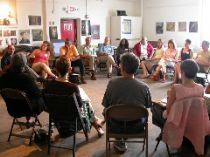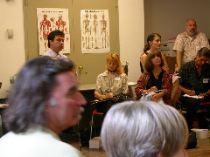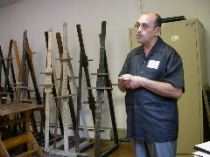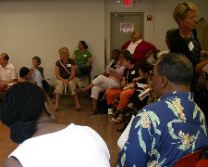
Libby told you about our day in the trenches brainstorming for LINC Philadelphia. Her report was comprehensive so here is just a little bit of people-watching information and some (perhaps) random thoughts about the art scene as reflected in what I saw and heard.
For starters the earnestness quotient was off the charts. Everybody seemed to be speaking from the heart — both the official speakers and the audience participants. There was little of what I considered posturing or outright political maneuvering in what seemed to be an open discussion of issues by experts (who knew about things like tax code, insurance and collateral pools, and housing options) and artists from the theatre, dance and visual arts community who seemed hungry for answers and eager for some breakthrough development. (top image is the session on entrepreneurship I attended in the afternoon)
If the idea behind the all-day session was to sound out the community and discover “real needs” around which to build a proposal and raise money I’d say there’s some work to do. The needs expressed are enormous: In addition to the expected (affordable housing/studio space, health insurance) people expressed a need for structure — some group or coalition to organize and whip the town’s various communities into a more cohesive group that could effectively argue for their needs. Education is a big need, not college-type but real world. People don’t know about things like the tax code or how to approach a bank to get a loan to support a project.
Space

I went to two break-out sessions, Space and Entrepreneurship. Space had about 50 people in attendance (roughly a third of the group) hoping to catch more from Artspace‘s charismatic Chris Velasco who seemed to have a lot of facts and figures at his fingertips. (For example, Velasco said at one point that cities with strong philanthropic foundations — like Philadelphia — usually have city governments that step back and let the foundations take the lead initiating projects. Wow, this made sense. Look at the recent foundation-led Barnes move, in which the city was in the car but definitely in the back seat — and now, of course, with this initiative.) Everyone wanted Velasco’s ear. (image is the session on space. Artspace guy Chris Velasco is in the background, left. That’s Nick Kripal of the Crane Art Center/Icebox Project Space in the foreground. See picture bigger here.)
Velasco’s in charge of a study about Philadelphia artists’ space needs and said he hopes that by the end of his project’s three phases they will have created three new live/work space buildings in “downtown Philadelphia.” When questioned about what “downtown” meant (not a Philly word, here we use “center city”) Velasco said he wasn’t sure but that there would be some elasticity built in to the definition. Elasticity is good because we’ve got a rather elastic arts district which sprawls here and there and some of the best art hot spots are nowhere near downtown — like the Kensington/American st. corridor with the Ice Box and the 1801 Artists building.

Guillermo Salas who runs a CDC in North Philadelphia that builds housing and has been working with arts groups to bring people to the Latino Corridor of town gave a pep talk on community organizing and how it can work but you have to know how to do it. (Salas, pictured here, used to be a banker, he said, so he’s got a lot of financial know-how.)
Edward Epstein who runs the Penn-affiliated 40th St. Residency program spoke about their project in West Philadelphia which is an artists’ work space program.
Zoe Strauss mentioned the soon-to-open Sterling Craft building on Passyunk near her studio that would be offering work space for artists and a gallery. In response to a follow-up general question by the mediator about what she thought of rent in the $200-400 a month range, Strauss, not referring to the SterlingKraft building, said she thought that was high. (that’s Strauss, in the picture below, in green, near the exit door. See picture bigger here.)
[Ed. note: 08/13/05, the above paragraph has been corrected to clear up some mis-information about what Strauss said in the space session. The correction is in bold. For complete clarification and more see post from Strauss here.]

Linda Goss, who represented a group of folk artists called “Keepers of the Culture” was one of several artists who made impassioned statements about including all artists in the discussions. Goss said that over the 10-years her organization has been in operation one after another of the venues they used for programming have closed — like the Clef Club, Freedom Theatre, the Black Lily.
Entrepreneurship
In the session on entrepreneurship, run by newly-hired Pew/PEI staffer, Jeremiah Misfeldt, the large group of artists seemed of two minds about the subject. Some, using language like “selling out,” seemed to distrust the profit motive and the idea of artist as entrepreneur. Others, like Susan Meyers, a visual artist who just hired on to work on the New Landmarks Program at the Fairmount Park Art Association, embraced entrepreneurship as the artist’s natural way of life. “Entrepreneurship is creative thinking to get what you want. It’s a methodology,” she said.
Judith Luther Wilder of Los Angeles’s Center for Cultural Innovation expressed a sentiment I’ll go with: “Taking the profit out of entrepreneurship is missing the point.”
There was a lot of talk here about lack of money and fear of risk-taking, which seem to go together if you ask me.

My feeling after sitting and absorbing what was said and registering the intensity with which it was said is that there’s a high level of frustration among Philadelphia artists. No surprise here. I suppose that could be said about any group of artists in any community. What I wonder at is the level of disenfranchisement that was expressed. I can’t figure out if that is because of the lack of civic support historically for the arts in Philadelphia creating a culture of second class citizenship for artists or if it goes deeper into a kind of Philadelphia conservative can’t-do mindset that seems rampant here.
Just adding up the negatives for the artists to operate here feels like hammering a nail in a coffin: A stiff sales tax on art, bang. A business license requirement on artists, bang. A mayor who just axed the office of art and culture, bang. An art museum which rarely includes programming with living local artists, bang. And until recently, with the Greater Philadelphia Cultural Alliance’s outreach to the business community, a business community that didn’t “get” the value of the art dollar and would rather build sports stadiums — two — with millions of public tax dollars, than give anything to the arts except a crumb or token, bang, bang.
But whatever. The enlightened foundations, Pew and Bartol are going to work hard to distill this down to a need that can be addressed by $200,000 (half from LINC, half from local funders). That could be seed money for something significant. My hope is that they can make it real enough to work. (last image is Bartol Foundation‘s Beth Feldman Brandt and Pew‘s Melissa Franklin at the end of the day wrap up speaking in the Fleisher Art Memorial lovely old Sanctuary. See picture bigger here.)









